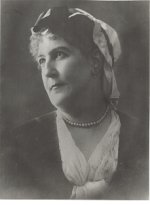Richard Burton meets Isabel Arundell
This is part of a local history note on Sir Richard and Lady Isabel Burton. See the start of this local history note.
 Lady Isabel Burton (nee Arundell). Photograph.
Lady Isabel Burton (nee Arundell). Photograph.
In May 1849 he sailed for home and spent his leave visiting relatives in England and on the continent; it was in Boulogne that he first saw his future wife, Isabel Arundell. Born on 20th March 1831 in London, Isabel came from an old and distinguished Catholic family and between the ages of 10-16 she was educated at a convent in Chelmsford, near her home in Ingatestone. The family moved back to London a year later and in August 1850 went to Boulogne where she saw Richard and knew at once that he would be her husband. This was what had been told her by a Romany gipsy, Hagar Burton, whom she had been friendly with in Essex:
“You will cross the sea, and be in the same town with your destiny and know it not. Every obstacle will rise up against you, and such a combination of circumstances, that will require your courage, energy and intelligence to meet them. Your life will be like one swimming against big waves; but God will be with you, so you will always win. You will fix your eye on your polar star, and you will go for that without looking right or left. You will bear the name of our tribe [Burton], and be proud of it. You will be as we are, but far greater than we. Your life is all wandering, change and adventure. One soul in two bodies, in life or death, never long apart. Show this to the man you take for your husband.”
Isabel also had a clear idea about her future husband. Earlier that year she had written in her diary:
“As God took a rib out of Adam and made a woman of it, so do I, out of a wild chaos of thought, form a man unto myself. My ideal is about six feet in height; he has broad and muscular shoulders, a powerful, deep chest, he is an Hercules of manly strength. He had black hair, a brown complexion, a clever forehead, sagacious eyebrows, large, black wondrous eyes – those strange eyes you dare not take your off them – with long lashes. He is a soldier and a man; he is accustomed to command and to be obeyed… He is a gentleman in every sense of the word; and of course he is an Englishman… He is a man who owns something more than a body; he has a head and a heart, a mind and soul. He is one of those strong men who lead, the master-kind who governs, and he has perfect control over himself.”
Isabel followed his exploits in the newspapers and heard news of him from others. Richard had always wanted to go in a pilgrimage to Mecca and was granted 12 months additional leave "so that he might pursue his Arabic studies in lands where the language is best learned." He left London in April 1853 and adopted several disguises in order to reach Mecca and the book Personal Narrative of a Pilgrimage to El-Medinah and Mecca was the result. On the steamer to Egypt Richard made friends with a fellow-passenger, William Strickland, a priest who was also a cousin of Isabel’s. He returned to India from Mecca and in 1854 he set off for Somaliland. The expedition had, as its Assistant Surveyor and Collector of Zoological Specimens, Lieutenant John Hanning Speke. The expedition was not without its dangers, Isabel wrote in her diary “We got the news of Richard’s magnificent ride to Hara, of his staying ten days in Hara, of his wonderful ride back, his most daring expedition, and then we heard of the dreadful attack by the natives in his tent…Richard with a lance through his jaw. They escaped in a native dhow to Aden, and it was doubtful whether Richard would recover…How can I be grateful enough for his escape?” Richard returned to England on sick leave in May 1855 and in October he went out to the Crimea. Isabel tried 3 times to join Florence Nightingale’s nurses, but was told she was too young and inexperienced. Richard returned to England in the latter part of 1855. Isabel remembered “We did not meet for some months after his return, though we were both in London, he planning his Central African expedition, and I involved in the gaieties of the season. In June I went to Ascot. There, amid the crowd of the racecourse, I met Hagar Burton, the gypsy, for the first time after many years, and I shook hands with her. "Are you Mrs Burton yet?" Hagar enquired. I shook my head. "Patience!" the gypsy answered, "it is just coming.” Two months later she met Richard Burton in London’s Botanical Gardens. Within 2 weeks he had proposed to her.
They did not marry as Richard set out on his travels once again in the spring of 1856, this time to Central Africa for the Royal Geographical Society with Speke as a member of the expedition. Shortly before he left, Richard’s book, First Footsteps in East Africa, a 2 volume account of his time in Somaliland was published. The expedition found Lake Tanganyika and on the return journey, Speke went off on his own and discovered Lake Victoria. Richard’s return to England was delayed by a fever and when he arrived in London in May 1859, he found that Speke had taken most of the credit for the success of the expedition.
Isabel, meanwhile, had spent 1858 touring Italy and Switzerland with her sister, Blanche, and brother-in-law. On his return Richard called on a friend to ask for Isabel’s address only to find her visiting the same friend. The Arundells, especially her mother, being devout Catholics, were not happy with the proposed marriage as Richard was thought to be an agnostic; his military career had not been a success; he had no prospects and no financial security. On 23rd May, Richard was presented with the Royal Geographical society’s Gold Medal, a decision made when the news of the expedition’s success reached England, months before Speke’s return. Richard’s story of the expedition, Lake Regions of Central Africa, came out in 1860.
Updated: 08 July 2016
 Stay up to date! Make sure you subscribe to our email updates.
Stay up to date! Make sure you subscribe to our email updates.
